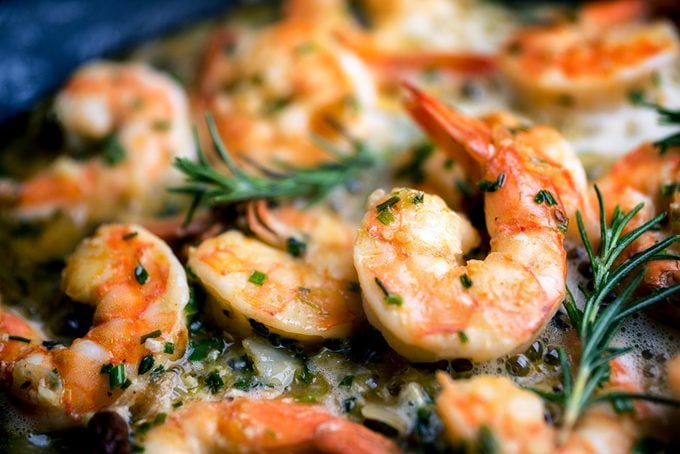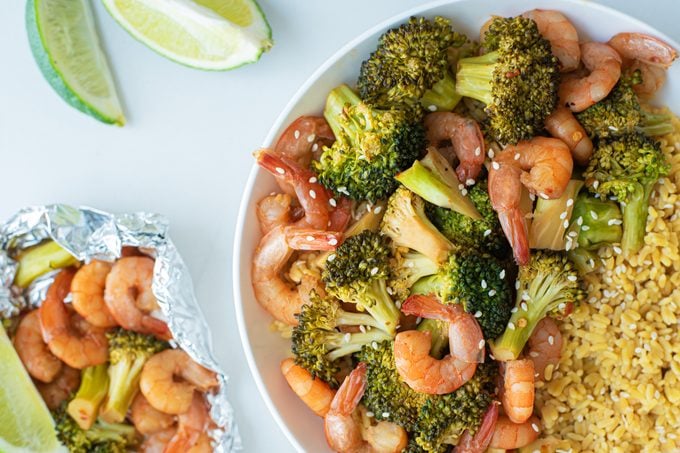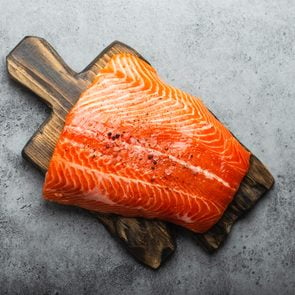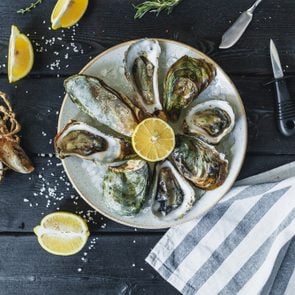Is Shrimp Healthy? 6 Shrimp Nutrition Facts to Know
Updated: Mar. 08, 2022
Love shrimp? Registered dietitians weigh in on whether this crustacean is good for you.
Shrimp nutrition basics
When you dig into shrimp scampi, no doubt you’re thinking about the delicious taste. But what about the health benefits? When it comes to shrimp nutrition, you’re in luck, because the seafood is oh-so-good for you.
“Shrimp is rich in protein and contains many beneficial nutrients—including omega-3 fatty acids, selenium, vitamin B12, iron, zinc, and iodine,” says Cindy Chou, a chef and registered dietitian nutritionist at Healthy Feels in Santa Monica, California.
“It’s also low in saturated fat and a source of astaxanthin, a carotenoid that gives shrimp its pink color after cooking.”
Research in the journal Marine Drugs found that astaxanthin has anti-inflammatory properties that may help increase HDL “good” cholesterol, although more research is needed, Chou notes.
What else should you know about shrimp nutritional data? Let’s take a look.

Different types of shrimp
Did you know that many different types of shrimp exist? Yup, and there are more than you probably realize.
Just in Florida, four shrimp species are harvested commercially, according to the Florida Department of Agriculture and Consumer Services. These include pink shrimp, brown shrimp, white shrimp (grayish with a blue, red, or green tinge on the legs and tail), and royal red shrimp (typically deep red but sometimes a grayish pink color).
Then, on the Atlantic coast, you’ll often find brown shrimp—while on the northern Gulf coast, lemon-yellow shrimp are more prevalent. You’ll also see blue shrimp, whiteleg shrimp, and many other varieties that come from around the world.
When you’re purchasing shrimp, you’ll find them fresh and frozen, as well as whole, with the head off, with the shell on, peeled, peeled and deveined, and with the tail on. Wow, that’s a lot of varieties!
And then there’s “regular” and “jumbo” shrimp, but you can disregard those labels. “Shrimp size is unregulated, so labels like ‘large’ or ‘jumbo’ are misleading,” says Jess DeGore, a registered dietitian and health coach in Pittsburgh, Pennsylvania.
“Instead, look for a range of numbers such as ’16-20,’ which indicates the number of individual shrimp it takes to make up one pound.”
Where shrimp comes from
In the United States, you’ll see shrimp from a variety of places. These locales include the United States (Florida and Oregon), Canada, Latin America, Ecuador, Asia, and Mexico.
To see which are the best choices in terms of sustainability and mercury content, the Environmental Defense Fund (EDF) has a helpful seafood selector. You can also look for the Marine Stewardship Council (MSC) blue label on a product’s package to know that you’re purchasing sustainable seafood.
The shrimp that the EDF gives the highest ratings include northern shrimp sourced from the United States and Canada; pink shrimp from Oregon; giant freshwater prawn in the United States, Canada, and Latin America; spot prawn from Canada; and spot prawns from the United States.
The lowest-rated shrimp in terms of sustainability include blue shrimp, Chinese white shrimp, imported shrimp and prawns, pink shrimp from the Gulf of Mexico and Mexico, and giant tiger prawn.
Shrimp health benefits
One of the biggest benefits that shrimp boasts: the eicosapentaenoic acid (EPA) and docosahexaenoic acid (DHA) omega-3 fatty acids it contains.
“Shrimp has a wide variety of health benefits due to its high omega-3 fatty acid content and that it contains a low level of mercury compared to other fish options,” DeGore says.
“It has an abundance of vitamins and minerals—and it’s one of the best food sources of iodine, an important mineral required for proper thyroid function and brain health.”
You also get a big serving of vitamin B12.
“Vitamin B12 is important in the making of red blood cells,” notes Brynn McDowell, a registered dietitian at the Domestic Dietitian in Livermore, California.
And shrimp boasts an incredible 20 grams of protein per 3-ounce cooked portion—making it an excellent source of protein. “Shrimp are primarily made up of water and protein, making it a great, low-calorie addition to meals,” McDowell adds.
(Here are the best fish to eat.)
Shrimp and disease prevention
Because of the amazing nutrients that shrimp provides, the seafood may help prevent certain diseases. In fact, the omega-3s that shrimp contains may help prevent cardiovascular disease, found a review study in Nutrients.
“Studies show that increasing your consumption of EPA and DHA omega-3s by 1 gram per day may reduce your risk of cardiovascular disease by 5.8 percent,” Chou says. “For reference, a 3-ounce serving of shrimp contains approximately 0.12 grams of each.”
Eating shrimp also helps decrease inflammation in the body. “Free radicals are unstable particles in the body that can damage cells and lead to inflammation,” McDowell says. “Research indicates that chronic inflammation can lead to higher instances of premature aging and diseases such as heart disease, certain cancers, dementia, and diabetes. Antioxidants help the body fight free radicals.”
Plus, shrimp boasts iodine. “This is an important mineral for thyroid and brain health,” Chou says. “Adequate iodine intake is important for preventing goiter.”
Goiter is an abnormal enlarged thyroid gland that can make it hard to breathe or swallow. You’ll get additional thyroid-benefitting nutrients from shrimp. “We need selenium, zinc, copper, iodine, and calcium for our thyroids to function properly, and shrimp contains all five of these minerals,” McDowell says.

Shrimp nutrition facts
Shrimp’s nutrition value is pretty incredible. Here are the nutrition facts, including the recommended daily values (DVs)—for a 3-ounce serving of cooked shrimp.
- Calories: 84
- Total Fat: 0 g (0 percent DV)
- Protein: 20 g (40 percent DV)
- Carbohydrates: 0 g (0 percent DV)
- Sodium: 94 g (5 percent DV)
How much shrimp to eat
Just how much shrimp is OK to eat? Well, the 2020-2025 Dietary Guidelines for Americans say adults should aim for two 4-ounce servings of seafood per week. However, many experts recommend eating up to 12 ounces per week.
“The Environmental Protection Agency (EPA) suggests that eating up to three 4-ounce servings of seafood per week is considered safe,” says Chou, who notes that shrimp contains lower levels of methylmercury than many other types of seafood.
Risks and side effects of shrimp
Allergic reaction
Probably the most important thing to know about shrimp, in terms of potential risks, is that it’s one of the eight major food allergens. That means people with an allergy may experience severe and sometimes life-threatening anaphylaxis when consuming it.
“More mild reactions to be aware of include a stuffy nose, sneezing, itchy skin, hives, tingling in the mouth, abdominal pain, and nausea,” DeGore says. If you’re allergic to shrimp, avoid eating it and chat with an allergist about keeping an EpiPen on hand in case of emergency.
Iodine and mercury
Other risks include over-consuming mercury or iodine. “Although it’s highly unlikely, eating too much shrimp could lead to high levels of iodine or methylmercury,” Chou says.
“For adults, the tolerable upper intake level (UL) of iodine is 1,100 micrograms per day. Three ounces of shrimp contains 13 micrograms, which means you would have to eat more than 15 pounds per day to reach that level.” And since the level of methylmercury in shrimp is low, eating 12 ounces or less each week shouldn’t be a concern, she adds.
Gout
Additionally, eating too much shellfish may lead to an increased risk of gout, a form of inflammatory arthritis, Chou adds. Of course, a diet with variety avoids this issue.
“It’s important to remember that the goal of a healthy diet and lifestyle is variety and that too much of any one thing is not ideal,” McDowell says.
Cholesterol
If you’re worried about the cholesterol that shrimp contains, don’t be too concerned. While shrimp contains 161 milligrams of cholesterol (54 percent DV) per 3-ounce serving, current research suggests saturated fat has a bigger impact on the body’s cholesterol levels, versus dietary cholesterol.
“The American Heart Association indicates that the key to reducing cholesterol levels in the body is to focus on limiting foods high in saturated and trans fats,” McDowell says.
“Shrimp is low in saturated fat and doesn’t contain any trans fats. However, people with high cholesterol or cardiovascular disease should always consult with their doctor and/or registered dietitian for specific recommendations and guidelines on high-cholesterol foods in their diets.”
How to eat shrimp

You can enjoy shrimp in so many delicious recipes! “Shrimp is super versatile and can be prepared in a plethora of ways—grilled, sautéed, broiled, poached, sous vide, and boiled,” DeGore says.
You do have to take some steps to make it ready for cooking, though.
“Prior to cooking, always clean and devein shrimp by cutting through the shell opposite the tail and picking out the ‘vein’ that runs along the back,” says DeGore, who notes the “vein” isn’t really a vein; it’s actually the shrimp’s digestive tract! Preparation with tail and shell is optional.
Of course, how you prepare shrimp will affect the healthfulness of the meals you prepare. “Often, shrimp is breaded, fried, or served in a butter sauce, which means that additional calories, saturated fats, and trans fats might be added,” McDowell says.
Chou prefers steaming or boiling.
“If you don’t mind the extra work of peeling, steaming, or boiling, shrimp with its shell on adds extra sweetness and depth in flavor. As a chef, I also use shrimp shells to make flavorful seafood stocks and sauces.”
Shrimp recipes to try
- 36 delicious fish recipes
- Dumplings with snow pea leaves and shrimp from Chou
- Mediterranean sauteed shrimp with herb sauce from McDowell
- Grilled shrimp and rice foil pack from Kelsey Sackmann, RD
- Spicy grilled shrimp kebobs from McDowell
- Shrimp spring rolls with ginger peanut sauce from Julie Kay Andrews, RD




















